World Cuisines
How to Make authentic Italian Pasta Recipe
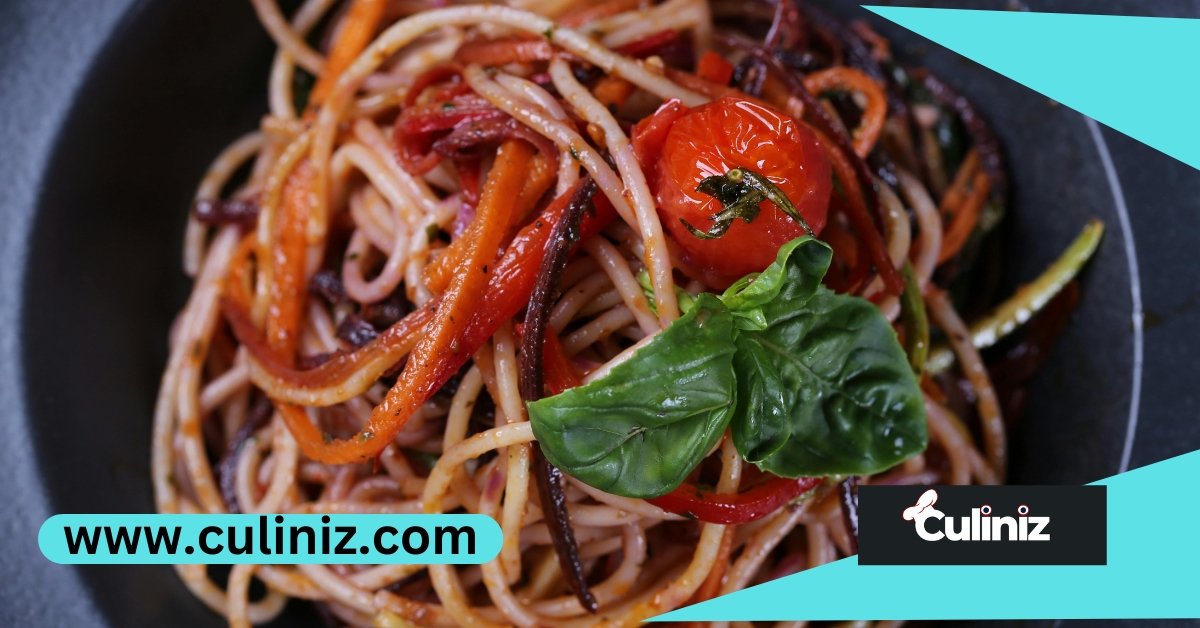
Introduction
Italy’s rich culinary tradition has gifted the world countless beloved dishes, but none as iconic as pasta. Whether you prefer a quick meal or a gourmet dish, Italian pasta offers versatility for any occasion. Today, we’ll delve into a classic Italian pasta recipe, highlighting techniques, tips, and secrets that ensure you can create an authentic dish from scratch.
The History of Italian Pasta
Italian pasta has a storied history dating back centuries. It is more than just a food staple; it’s a cultural symbol representing tradition, family, and culinary artistry. Though pasta has evolved, its core ingredients—flour and water—have remained unchanged.
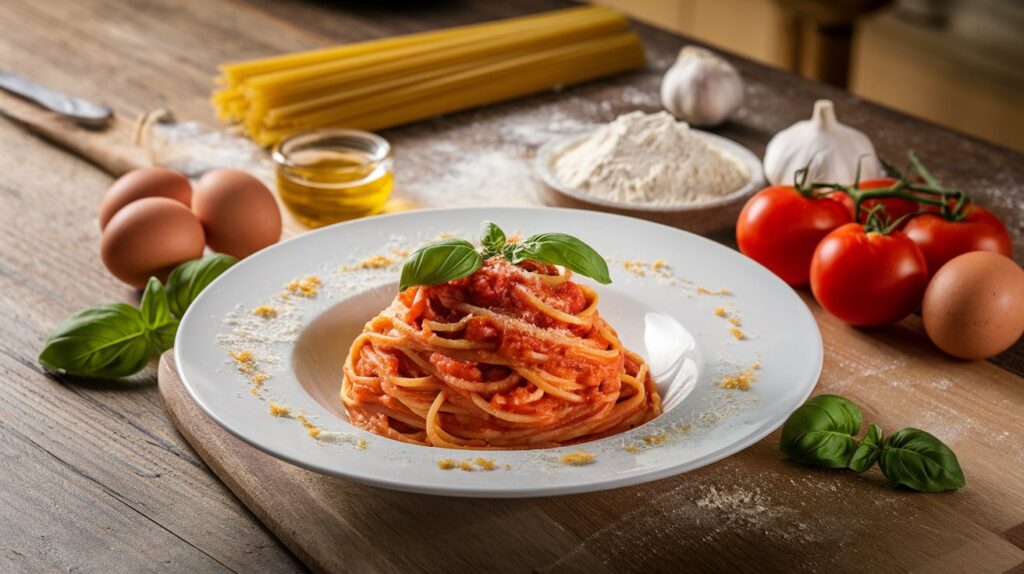
Why Homemade Pasta is Special
Making pasta at home elevates the flavor, texture, and quality of your dish. Unlike store-bought versions, homemade pasta absorbs sauces better and gives you control over the thickness and shape, adding a personalized touch to your recipe.
Ingredients for Classic Italian Pasta Recipe
For the pasta dough:
- 2 cups of all-purpose flour (or 00 flour for authenticity)
- Three large eggs
- A pinch of salt
- 1 tbsp of olive oil (optional)
For the sauce (Pomodoro):
- One can (14.5 oz) of peeled tomatoes (preferably San Marzano)
- Two cloves of garlic, minced
- 4 tbsp olive oil
- Fresh basil leaves
- Salt and pepper to taste
- Parmesan cheese for garnish
Step-by-Step Instructions
- Making the Pasta Dough:
- Create a mound of flour on a clean surface and form a well in the center.
- Crack the eggs into the well, add a pinch of salt, and slowly whisk the eggs, incorporating the flour gradually.
- Knead the dough for 8-10 minutes until it becomes smooth and elastic.
- Wrap the dough in plastic and let it rest for 30 minutes.
- Rolling and Cutting the Pasta:
- After resting, roll out the dough using a rolling pin or pasta machine to your desired thickness.
- Cut the pasta into your preferred shape (spaghetti, fettuccine, or pappardelle).
- Let the pasta dry slightly before cooking.
- Cooking the Pasta:
- Boil a large pot of salted water and cook the pasta for 2-4 minutes (fresh pasta cooks faster than dried).
- Preparing the Pomodoro Sauce:
- Heat olive oil in a pan over medium heat and add the minced garlic.
- Once fragrant, add the peeled tomatoes and season with salt and pepper.
- Let it simmer for 15-20 minutes until thickened.
- Add fresh basil leaves for a burst of flavor.
- Combining Pasta and Sauce:
- Once the pasta is cooked, drain it and immediately toss it into the sauce.
- Mix well, ensuring the pasta absorbs the sauce.
- Garnish with freshly grated Parmesan and more basil if desired.
Tips for a Perfect Italian Pasta Recipe
- Use fresh ingredients: Always opt for fresh basil, garlic, and high-quality tomatoes for the best flavor.
- Don’t overcook the pasta: Fresh pasta cooks quickly, so always test for the perfect al dente texture.
- Pasta water: Add a spoonful of pasta water to the sauce for a silkier consistency.
Pairing Suggestions
- Wine: A light, fruity red wine such as Chianti pairs perfectly with a simple pasta dish.
- Side dish: Serve your pasta with a classic Caprese salad or garlic bread.
Common Mistakes to Avoid
- Overworking the dough: Be gentle when kneading to avoid tough pasta.
- Undersalting the water: Pasta water should be as salty as the sea to enhance the flavor.
- Overcooking the pasta: Always monitor fresh pasta, as it can overcook quickly.
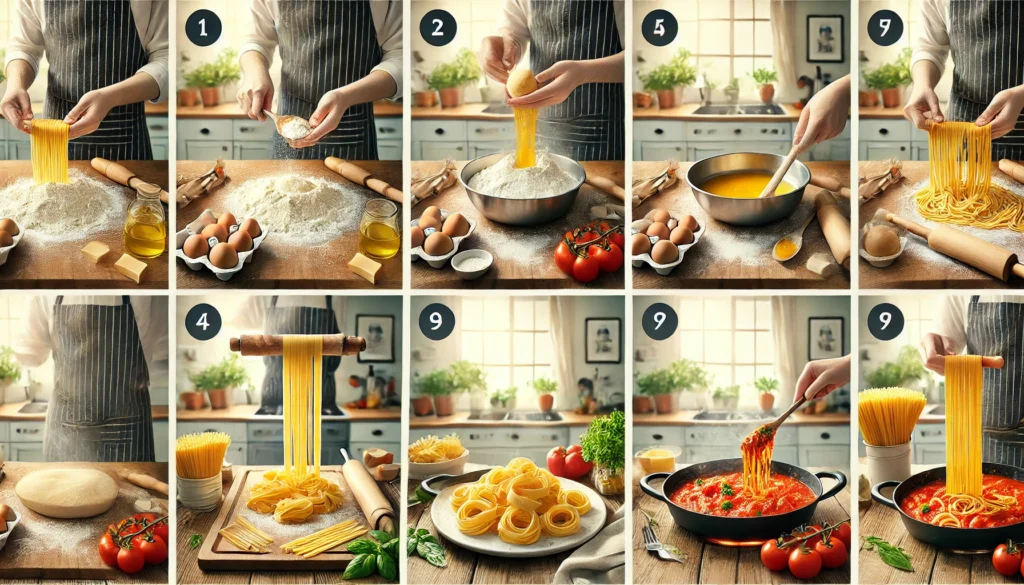
Tips for storing leftover Italian pasta:
- Store Pasta Separately from Sauce: If possible, store the cooked pasta and sauce in separate containers to prevent the pasta from absorbing too much sauce and becoming mushy.
- Use Airtight Containers: To keep leftover pasta and sauce fresh and prevent them from drying out, place them in airtight containers.
- Refrigerate: Leftover pasta and sauce can be stored in the refrigerator for up to 3-5 days. Ensure the containers are sealed tightly to preserve freshness.
- Freezing Pasta: For more extended storage, freeze cooked pasta. Let the pasta cool, spread it out on a baking sheet to freeze in individual pieces, then transfer to freezer-safe bags or containers. You can store frozen pasta for up to 2 months.
- Freezing Sauce: Tomato-based sauces like Pomodoro freeze well. Pour the cooled sauce into a freezer-safe container or bag, leaving some room at the top for expansion. Freeze for up to 3 months.
- Reheating Pasta: To reheat, place the pasta in a pan with a little bit of water or olive oil to help loosen the pasta and heat it evenly. For frozen pasta, thaw in the fridge overnight before reheating.
- Reheating Sauce: Heat the sauce over low to medium heat, stirring occasionally, until warm. If it has thickened too much during storage, add a splash of water or broth.
Tips for storing leftover Italian pasta:
- Store Pasta Separately from Sauce: If possible, store the cooked pasta and sauce in separate containers to prevent the pasta from absorbing too much sauce and becoming mushy.
- Use Airtight Containers: To keep leftover pasta and sauce fresh and prevent them from drying out, place them in airtight containers.
- Refrigerate: Leftover-pasta and sauce can be stored in the refrigerator for up to 3-5 days. Ensure the containers are sealed-tightly to preserve freshness.
- Freezing Pasta: For more extended storage, freeze cooked pasta. Let the pasta cool, spread it out on a baking sheet to freeze in individual pieces, then transfer to freezer-safe bags or containers. You can store frozen pasta for up to 2 months.
- Freezing Sauce: Tomato-based sauces like Pomodoro freeze well. Pour this cooled sauce into a freezer-safe container or bag, leaving some room at the top for expansion. Freeze for up to 3 months.
- Reheating Pasta: To reheat, place the pasta in a pan with a little bit of water or olive oil to help loosen the pasta and heat it evenly. For frozen pasta, thaw in the fridge overnight before reheating.
- Reheating Sauce: Heat the sauce over low to medium heat, stirring occasionally, until warm. If it has thickened too much during storage, add a splash of water or broth.
Conclusion
An Italian pasta recipe is more than just a meal; it’s an experience. By mastering the basics of making fresh pasta and a simple Pomodoro sauce, you can bring the taste of Italy into your kitchen. This recipe is perfect for anyone looking to cook a wholesome, authentic Italian meal.
FAQ
Q: Can I use store-bought pasta for this recipe?
A: Absolutely! While homemade–pasta provides a richer texture and flavor, store-bought pasta works just as well with the Pomodoro sauce. Just be sure to cook the pasta-al-dente for the best result.
Q: What type of flour is best for making pasta?
A: The traditional choice for Italian pasta is “00” flour, which is finely ground and gives a smooth texture. However, all-purpose flour works, too, if you don’t have access to “00” flour.
Q: How long should I knead the pasta dough?
A: Knead the dough for 8-10 minutes until it’s smooth and elastic. This helps develop the gluten, which gives pasta its chewy texture.
Q: Can I freeze homemade pasta?
A: Yes! Fresh pasta can be frozen. Lay the pasta out in a single layer on a baking sheet to freeze, then transfer to a zip-top bag or container. Cook from frozen for an additional 1-2 minutes.
Q: How do I know when the pasta is cooked?
A: Fresh pasta cooks much faster than dried pasta. It usually takes 2-4 minutes. The best way to check is to taste the pasta for the perfect al dente texture—firm to the bite but not hard.
Q: Can I add other ingredients to the Pomodoro sauce?
A: Yes, you can customize your sauce by adding ingredients like chili flakes for a spicy kick, olives for a salty flavor, or even some cream for a richer texture.
Q: What can I serve with the pasta?
A: A simple side dish like garlic bread or a Caprese salad complements the pasta well. You can also pair it with a light red wine such as Chianti or Barbera.
Next Article / How to Make Delicious Chicken Salad from Leftover Chicken

World Cuisines
Korean Cucumber Salad (Oi Muchim) – A Quick, Refreshing Side Dish
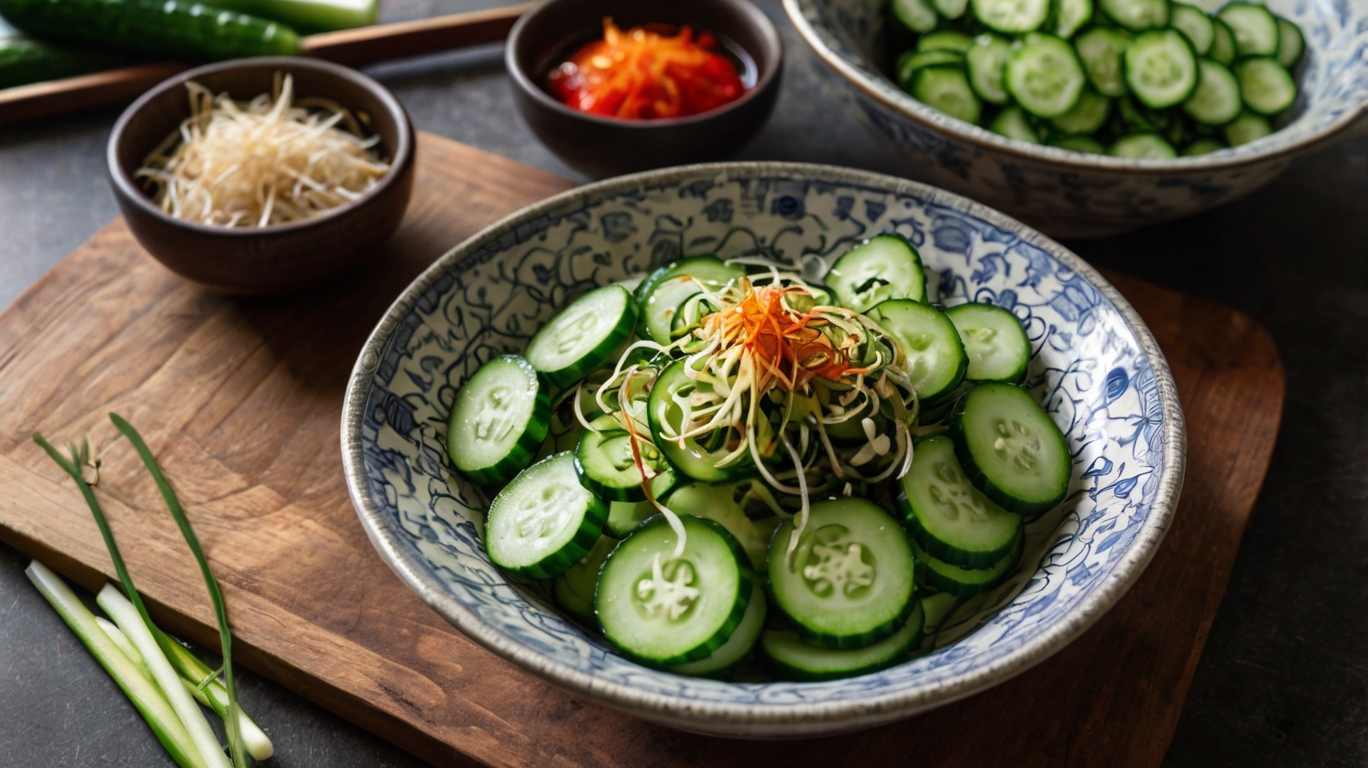
If you’re looking for a quick, flavorful, and healthy side dish, Korean Cucumber Salad (Oi Muchim) is the answer. This vibrant salad is a staple in Korean cuisine, known for its refreshing crunch and spicy-tangy flavor. Best of all, it’s ready in just 10 minutes! Whether you’re serving it alongside Korean BBQ, rice bowls, or enjoying it as a light snack, this salad is sure to impress. Let’s dive into the recipe and tips to make it perfect every time.
What is Korean Cucumber Salad?
Oi Muchim is a simple yet delicious salad made with crisp cucumbers, garlic, green onions, and a flavorful seasoning of soy sauce, gochugaru (Korean red pepper flakes), and sesame oil. It’s light, refreshing, and pairs perfectly with grilled meats, rice dishes, or even as a snack. The combination of spicy, tangy, and slightly sweet flavors makes it a crowd-pleaser.
Ingredients
- 2 medium cucumbers (English or Persian)
- 2 cloves garlic, minced
- 2 green onions, thinly sliced
- 1 tbsp soy sauce (or tamari for gluten-free)
- 1 tbsp gochugaru (adjust to taste)
- 1 tbsp rice vinegar
- 1 tsp sesame oil
- 1 tsp sugar or honey
- 1 tsp toasted sesame seeds (optional)
Step-by-Step Instructions
- Prepare the Cucumbers: Wash and thinly slice the cucumbers. For extra crunch, leave the skin on. If using larger cucumbers, cut them in half lengthwise and scoop out the seeds to prevent excess water.
- Make the Dressing: In a small bowl, mix together the minced garlic, soy sauce, gochugaru, rice vinegar, sesame oil, and sugar. Adjust the spice level by adding more or less gochugaru.
- Combine and Toss: Place the sliced cucumbers in a large bowl. Add the dressing and sliced green onions. Toss everything together until the cucumbers are evenly coated.
- Serve and Enjoy: Transfer the salad to a serving dish and sprinkle with toasted sesame seeds for added flavor and texture. Serve immediately or chill in the fridge for 30 minutes for a cooler, refreshing taste.
Tips for the Perfect Korean Cucumber Salad
- Cucumber Choice: Use fresh, firm cucumbers like English or Persian varieties. They have fewer seeds and thinner skin, making them ideal for this salad.
- Spice Level: Adjust the gochugaru to suit your taste. If you’re new to Korean spices, start with ½ tbsp and add more as needed.
- Make Ahead: While this salad is best enjoyed fresh, you can store it in the fridge for up to 24 hours. Drain any excess liquid before serving.
- Add-Ins: Feel free to add shredded carrots, radishes, or even a splash of lime juice for extra flavor and color.
Why You’ll Love This Recipe
- Quick and Easy: Ready in just 10 minutes, it’s perfect for busy weeknights or last-minute meals.
- Healthy and Refreshing: Low in calories and packed with flavor, it’s a guilt-free side dish.
- Versatile: Pairs well with Korean BBQ, rice bowls, or as a light snack.
Conclusion
Korean Cucumber Salad (Oi Muchim) is a must-try for anyone who loves bold, refreshing flavors. With its simple ingredients and quick preparation, it’s the perfect side dish to brighten up any meal. Give this recipe a try, and let us know how it turns out in the comments below
World Cuisines
How to Make Freddy’s French Fry Sauce: The Ultimate Copycat Recipe
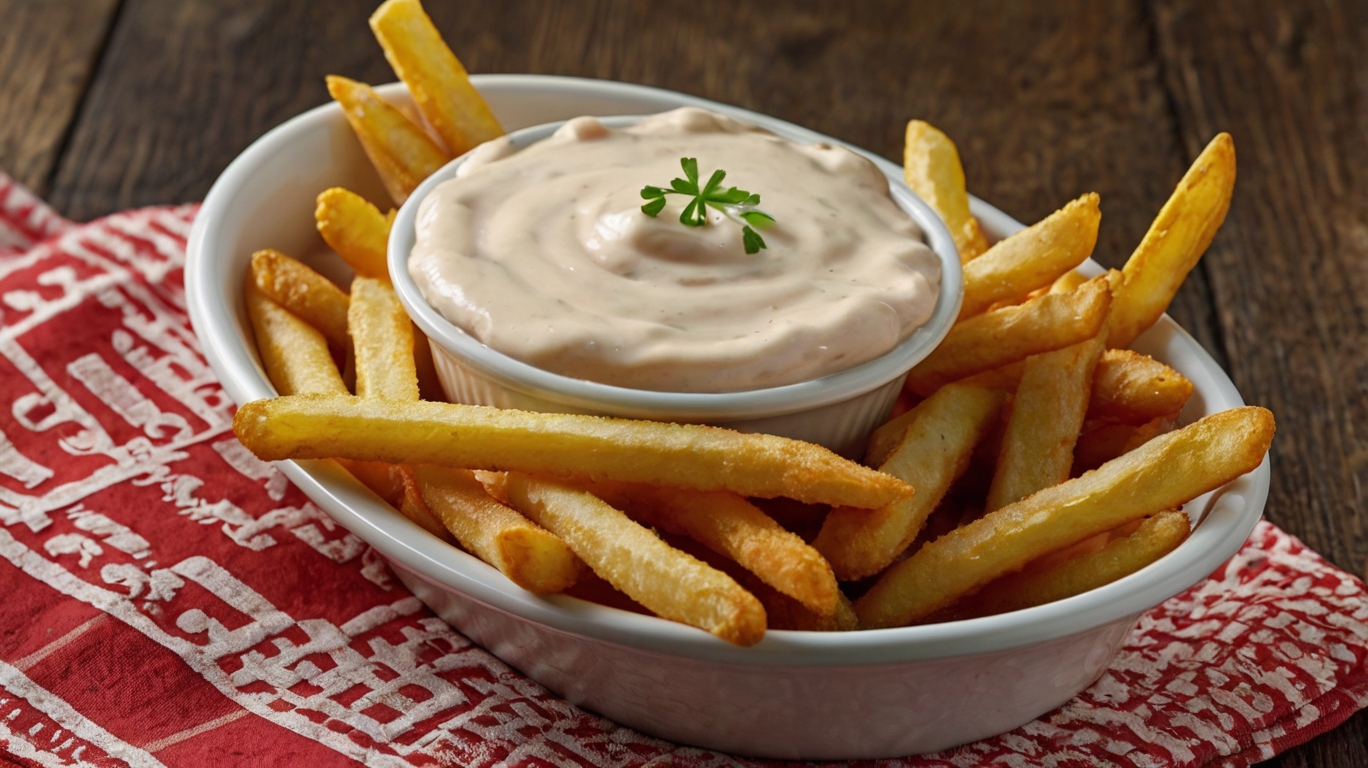
If you’ve ever dined at Freddy’s Frozen Custard & Steakburgers, you know their French fry sauce is legendary. That creamy, tangy, and slightly sweet dip is the perfect accompaniment to their crispy shoestring fries. But what if you could recreate that iconic Freddy’s French fry sauce recipe at home? Good news—you can! In this detailed guide, we’ll walk you through everything you need to know to make this delicious sauce in your own kitchen. Plus, we’ll share tips, tricks, and creative ways to use this versatile sauce.
What Makes Freddy’s French Fry Sauce So Special?
Freddy’s French fry sauce has a cult following for a reason. It’s a unique blend of creamy, tangy, and slightly sweet flavors that perfectly complements their golden, crispy fries. While the exact recipe is a closely guarded secret, we’ve cracked the code to create a homemade version that’s just as delicious. The key lies in the balance of ingredients—creamy mayonnaise, tangy ketchup, a hint of sweetness, and a secret ingredient that ties it all together.
Why Make Freddy’s French Fry Sauce at Home?
- Save Money: Dining out just for the sauce can add up. Making it at home is cost-effective and allows you to enjoy it whenever you want.
- Customize It: Adjust the ingredients to suit your taste preferences—add more spice, sweetness, or tanginess as you like.
- Impress Your Guests: Serve this sauce at your next gathering, and watch it disappear! It’s a guaranteed crowd-pleaser.
- Endless Uses: It’s not just for fries! Use it as a dip for burgers, chicken tenders, onion rings, or even veggies.
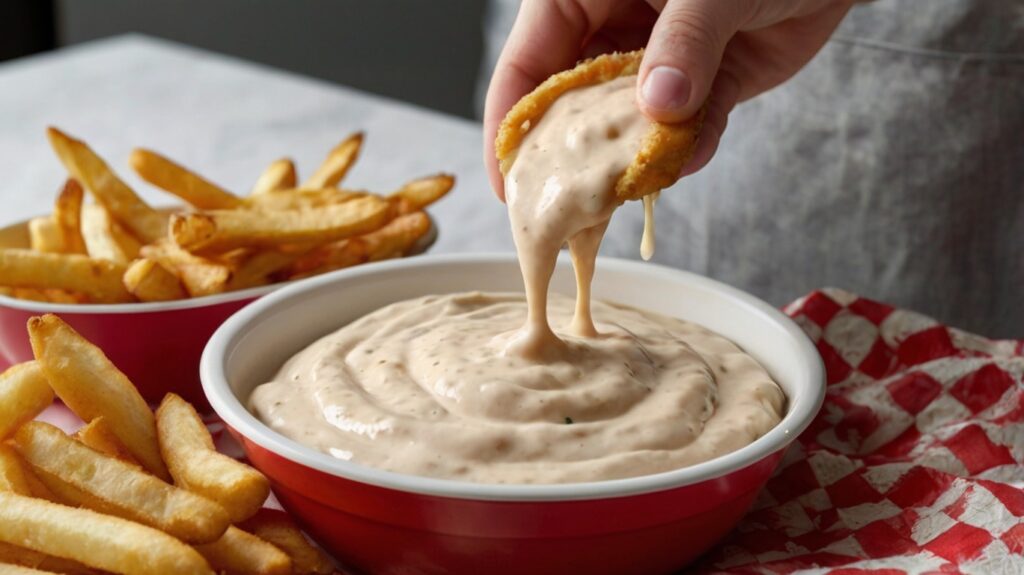
Freddy’s French Fry Sauce Recipe
Here’s the step-by-step guide to making Freddy’s French fry sauce at home. This recipe makes about 1 cup of sauce, but you can easily double or triple it for larger gatherings.
Ingredients:
- ½ cup mayonnaise (use high-quality mayo for the best flavor)
- 2 tablespoons ketchup
- 1 tablespoon distilled white vinegar
- 1 teaspoon sugar
- 1 teaspoon paprika
- ½ teaspoon garlic powder
- ½ teaspoon onion powder
- ¼ teaspoon salt
- ¼ teaspoon black pepper
- 2-3 tablespoons pickle juice (this is the secret ingredient!)
Instructions:
- Combine the Base Ingredients: In a medium-sized bowl, add the mayonnaise, ketchup, and white vinegar. Mix until smooth and well combined.
- Add the Spices: Stir in the sugar, paprika, garlic powder, onion powder, salt, and black pepper. Mix well to ensure the spices are evenly distributed.
- Incorporate the Secret Ingredient: Add the pickle juice, one tablespoon at a time, until you reach your desired consistency and flavor. The pickle juice adds a tangy kick that mimics the original Freddy’s sauce.
- Chill and Serve: Cover the bowl and refrigerate the sauce for at least 30 minutes to allow the flavors to meld. Serve with your favorite fries, burgers, or snacks.
Tips for Perfect Freddy’s French Fry Sauce
- Use High-Quality Ingredients: Since this sauce has a short ingredient list, the quality of each component matters. Opt for full-fat mayonnaise and fresh spices for the best flavor.
- Adjust the Sweetness: If you prefer a sweeter sauce, add an extra teaspoon of sugar. For a tangier flavor, increase the amount of pickle juice or vinegar.
- Experiment with Spices: Feel free to tweak the spice levels to suit your taste. A dash of cayenne pepper can add a subtle heat, while smoked paprika can give it a deeper, smoky flavor.
- Make It Ahead of Time: This sauce tastes even better the next day, so consider making it a day in advance to allow the flavors to fully develop.
- Storage Tips: Store the sauce in an airtight container in the refrigerator for up to 1 week. Stir well before serving if the ingredients have separated.
How to Serve Freddy’s French Fry Sauce
While this sauce is a natural pairing for fries, its versatility makes it a great addition to many dishes. Here are some creative ways to use it:
1. Classic French Fry Dip
Pair it with crispy shoestring fries, steak fries, or sweet potato fries for the ultimate dipping experience.
2. Burger Spread
Slather it on your homemade burgers for an extra burst of flavor. It pairs perfectly with beef, chicken, or veggie burgers.
3. Chicken Dip
Use it as a dipping sauce for chicken tenders, nuggets, or even fried chicken sandwiches.
4. Veggie Dip
Pair it with fresh veggies like carrots, celery, bell peppers, or cucumber slices for a healthier snack option.
5. Sandwich Sauce
Add it to sandwiches or wraps for a creamy, tangy twist. It works especially well with turkey, ham, or grilled cheese sandwiches.
6. Onion Ring Dip
Elevate your onion rings by serving them with this flavorful sauce.
7. Breakfast Companion
Try it as a dip for hash browns or breakfast potatoes for a delicious morning treat.
Frequently Asked Questions (FAQs)
1. Can I make this sauce healthier?
Yes! You can use light mayonnaise or Greek yogurt as a substitute for regular mayo. However, keep in mind that this may slightly alter the flavor and texture.
2. How long does Freddy’s French fry sauce last?
When stored in an airtight container in the refrigerator, the sauce will stay fresh for up to 1 week.
3. Can I freeze the sauce?
Freezing is not recommended, as mayonnaise-based sauces tend to separate and lose their creamy texture when thawed.
4. What if I don’t have pickle juice?
If you don’t have pickle juice, you can substitute it with a combination of white vinegar and a pinch of salt. However, pickle juice adds a unique tanginess that’s hard to replicate.
5. Can I make this sauce spicy?
Absolutely! Add a dash of hot sauce, cayenne pepper, or chili powder to give it a spicy kick.
The History of Freddy’s Frozen Custard & Steakburgers
Freddy’s Frozen Custard & Steakburgers was founded in 2002 in Wichita, Kansas, by brothers Bill and Randy Simon, along with their business partner, Scott Redler. The restaurant was named after their father, Freddy Simon, who inspired their commitment to quality and hospitality. Freddy’s is known for its cooked-to-order steakburgers, crispy shoestring fries, and, of course, its famous French fry sauce. The sauce has become a signature item, beloved by customers across the country.
Why You’ll Love This Recipe
This Freddy’s French fry sauce recipe is quick, easy, and requires no special cooking skills. With just a few pantry staples, you can recreate the magic of Freddy’s signature sauce in your own kitchen. Plus, it’s a fun way to bring a taste of your favorite restaurant home. Whether you’re hosting a party, enjoying a family dinner, or simply craving a delicious dip, this sauce is sure to impress.
Final Thoughts
Freddy’s French fry sauce is more than just a condiment—it’s a flavor experience that elevates any meal. With this homemade recipe, you can enjoy that iconic taste anytime, anywhere. Whether you’re dipping fries, spreading it on a burger, or pairing it with veggies, this sauce is a versatile and delicious addition to your culinary repertoire.
So, what are you waiting for? Grab your ingredients and whip up a batch of Freddy’s French fry sauce today. Your taste buds will thank you!
fallow my page also CulinizCooking
World Cuisines
Thai Basil Eggplant Recipe: A Flavorful Vegan and Gluten-Free Delight
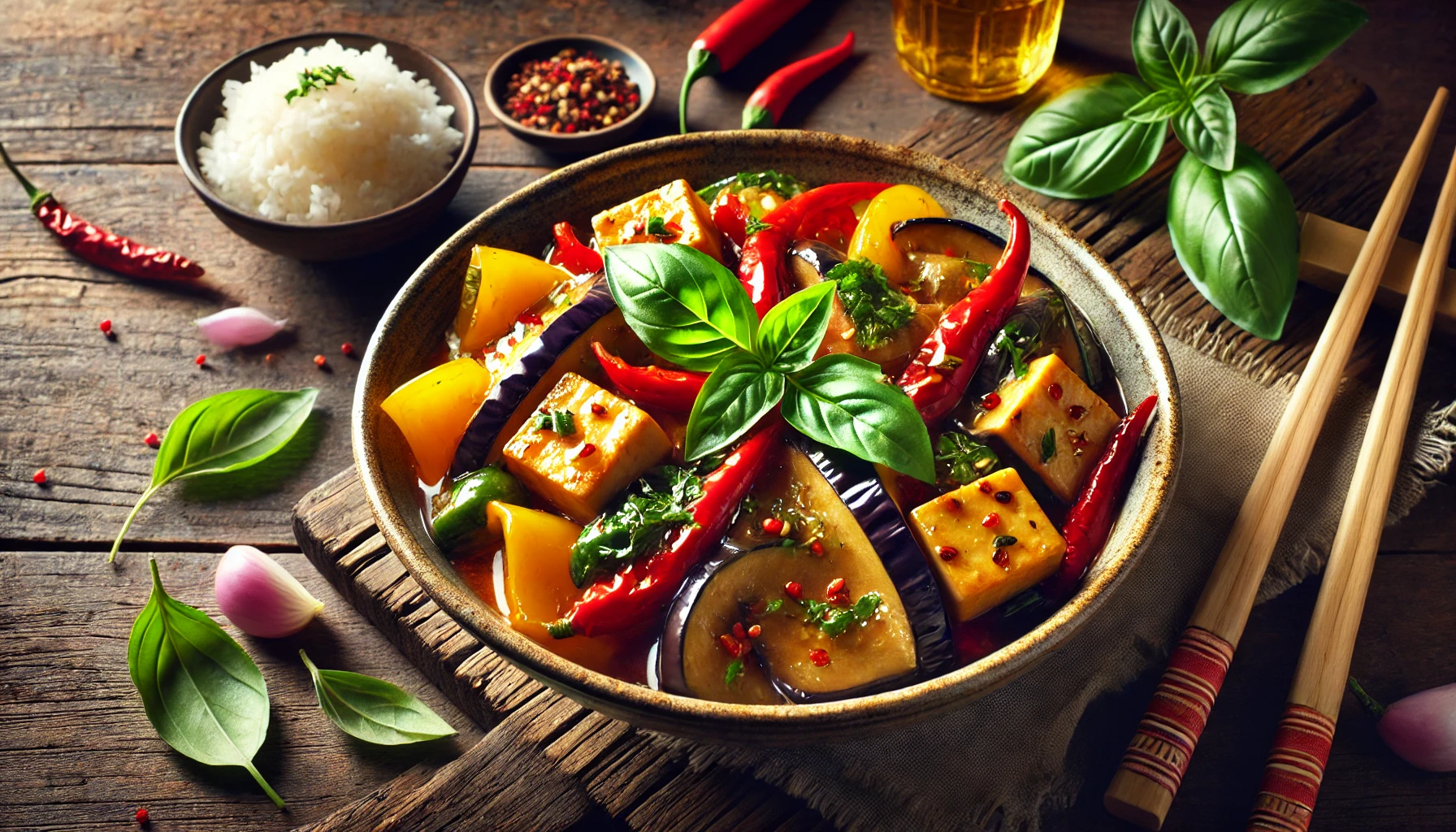
Thai cuisine has captivated food enthusiasts worldwide with its dynamic interplay of bold flavors and wholesome ingredients. The Thai Basil Eggplant recipe is no exception, offering a delightful blend of sweet, savory, and slightly spicy flavors. Whether you’re new to Thai cooking or a seasoned enthusiast, this dish is a must-try for its simplicity and vibrant taste. Here’s a comprehensive guide to preparing this delicious and healthy dish.
Why You’ll Love This Recipe
- Healthy and Nutritious: Packed with vegetables, tofu, and aromatic basil, this dish is a powerhouse of nutrients.
- Vegan and Gluten-Free: With simple ingredient swaps, it caters to diverse dietary preferences.
- Easy to Make: A quick preparation process makes it ideal for busy weeknights or lazy weekends.
Ingredients
For the Main Dish:
- 1 large Italian eggplant or 2 medium Japanese/Chinese eggplants
- 1 green bell pepper, thinly sliced
- 1 red bell pepper, thinly sliced
- 1 yellow bell pepper, thinly sliced
- 1 white onion, halved and thinly sliced
- 14 oz firm tofu, cut into cubes
- 2 cloves garlic, minced
- 4 tbsp cooking oil (coconut, grapeseed, or avocado oil)
- Fresh basil leaves
For the Sauce:
- 4.5 tbsp hoisin sauce (e.g., Koon Chun Hoisin Sauce or gluten-free Sun-Luck Hoisin Sauce)
- 1/2 cup tamari or soy sauce
- 1/4 cup water
- 2 tsp chili sauce (e.g., Huy Fong Chili Sauce)
- 2 tsp cornstarch
Step-by-Step Instructions
Preparing the Eggplant:
- Slice the eggplant: If using Italian eggplant, cut it into slabs, then into diagonal pieces. For Japanese/Chinese eggplants, slice lengthwise and cut diagonally.
- Heat 2-3 tablespoons of oil in a large non-stick pan over medium heat.
- Add the eggplant pieces, toss to coat with oil, and cook with a small amount of water over low-medium heat. Cover and stir occasionally until tender but firm. Set aside.
Preparing the Tofu and Vegetables:
- Press the tofu to remove excess moisture, then cut into cubes.
- Pan-fry tofu on medium-high heat until golden brown on most sides. Set aside.
- In the same pan, sauté onions and bell peppers with 1 tbsp oil until crisp-tender. Add minced garlic midway and stir until fragrant.
- Combine cooked tofu, vegetables, and eggplant in one pan.
Making the Sauce:
- Whisk together all sauce ingredients until cornstarch dissolves.
- Heat the combined eggplant, tofu, and vegetables over low-medium heat.
- Pour the sauce into the pan, stirring frequently until it thickens and coats the ingredients evenly.
- Turn off the heat, add freshly chopped basil, and mix well.
Serving Suggestions
Serve the Thai Basil Eggplant hot with:
- Steamed jasmine rice
- Brown rice
- Quinoa for a gluten-free option
Tips for Success
- Choosing the Right Eggplant: Japanese and Chinese eggplants are less bitter and ideal for this dish.
- Adjusting Spice Levels: Add more chili sauce or fresh chilies for extra heat.
- Time-Saving Tips: Cook the tofu and vegetables simultaneously in separate pans while preparing the eggplant.
- Storage: Refrigerate leftovers in an airtight container for up to 3 days. Reheat gently on the stovetop.
Nutritional Information (Per Serving)
- Calories: 185 kcal
- Carbohydrates: 14g
- Protein: 7g
- Fat: 11g
- Sodium: 1382mg
- Fiber: 1g
- Vitamin A: 735 IU
- Vitamin C: 79.4mg
Conclusion
Thai Basil Eggplant is a versatile and delectable dish that embodies the essence of Thai cuisine. With its rich flavors and straightforward preparation, it’s perfect for anyone looking to enjoy a restaurant-quality meal at home. Whether you’re cooking for yourself or hosting a dinner party, this recipe will undoubtedly impress.
Frequently Asked Questions (FAQ)
1. Can I use a different type of eggplant?
Yes, Italian eggplants work well, but Japanese and Chinese varieties are preferred for their tender texture and mild flavor.
2. What can I use instead of tofu?
You can substitute tofu with tempeh, seitan, or even chicken for a non-vegan option.
3. Is this dish spicy?
The dish has a mild spice level. Adjust the chili sauce to suit your preference.
4. Can I prepare this dish in advance?
Yes, you can prepare the components separately and combine them with the sauce just before serving.
5. What can I pair this dish with?
Pair it with other Thai-inspired dishes like Sweet Chili Lime Tofu or a fresh cucumber salad for a complete meal.
Embrace the flavors of Thailand with this easy, healthy, and satisfying recipe. Happy cooking!
fallow my page / Pinterest
-

 Sustainable Cooking6 months ago
Sustainable Cooking6 months agoHow to Make Vegetable Scrap Broth: A Zero-Waste Recipe
-

 World Cuisines5 months ago
World Cuisines5 months agoCream of Wheat Recipe: A Delicious Breakfast
-

 Sustainable Cooking5 months ago
Sustainable Cooking5 months agoHomemade Pumpkin Spice Creamer Recipe
-

 Sustainable Cooking6 months ago
Sustainable Cooking6 months agoHow to Make Delicious Chicken Salad from Leftover Chicken
-

 World Cuisines5 months ago
World Cuisines5 months agoHealthy Halloween Salad Recipes
-

 World Cuisines5 months ago
World Cuisines5 months agoThe Ultimate Guide to Blackened Grilled Lingcod Recipes
-

 Sustainable Cooking5 months ago
Sustainable Cooking5 months agoRoll sushi -How to Make Alaska Roll Sushi
-

 World Cuisines5 months ago
World Cuisines5 months agoBest Dairy-Free Pear Kugel Recipe







Pingback: Pasta Salad Recipe Italian – A Fresh and Flavorful Delight 2024
Pingback: The Ultimate Italian Pasta Salad Recipe: Fresh, Flavorful 2024